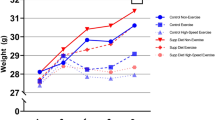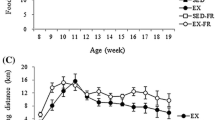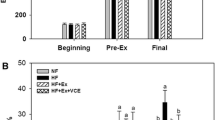Abstract.
The aim of this study was to determine whether decreased physical activity in exercise-trained young rats would result in a lower rate of bone gain or a reversal of the benefits of exercise. Thirty-five female Wistar rats, 6 weeks of age, were randomized into seven groups: 7 weeks of exercise (7EX), 7 weeks of sedentary control (7CN), 11 weeks of exercise (11EX), 7 weeks of exercise followed by 4 weeks of exercise cessation (7EX4C), 7 weeks of exercise followed by 4 weeks of decreased exercise frequency (7EX4F), 7 weeks of exercise followed by 4 weeks of decreased exercise intensity (7EX4I), and 11 weeks of sedentary control (11CN). The running intensity (speed) and duration were 25 m/min for 60 min/day at a frequency of 5 days/week. During the last 4 weeks, exercise frequency was reduced to 1 day/week in the 11EX4F group, and exercise intensity (speed) was reduced to 12 m/min in the 7EX4I group. After each period of exercise, the bone mineral content (BMC) of the proximal, middle, and distal tibiae, determined by dual-energy X-ray absorptiometry (DXA), was significantly greater in the 7EX and 11EX groups than in the 7CN and 11CN groups, respectively, but it was significantly lower in the 7EX4C group than in the 11EX group and did not differ significantly from the values of the 11CN group. Although the BMC of the proximal and middle tibiae did not differ significantly among the 7EX4F, 7EX4I, 7EX4C, and 11CN groups, the BMC of the distal tibia was significantly greater in the 7EX4F and 7EX4I groups than in the 11CN group and tended to be greater than in the 7EX4C group. The results of this study suggest that the effect of decreased exercise intensity and frequency on bone mass appears to be site specific in the tibia of the exercise-trained young rats. This study shows that exercise-trained young rats lose the benefits gained from exercise when exercise is completely ceased, resulting in the reduction of bone mass to levels that do not differ significantly from those of sedentary controls. At least, continuous exercise appears to be necessary for the maintenance of high bone mass.
Similar content being viewed by others
Author information
Authors and Affiliations
Additional information
Received: June 5, 2001 / Accepted: January 7, 2002
About this article
Cite this article
Shimamura, C., Iwamoto, J., Takeda, T. et al. Effect of decreased physical activity on bone mass in exercise-trained young rats. J Orthop Sci 7, 358–363 (2002). https://doi.org/10.1007/s007760200060
Issue Date:
DOI: https://doi.org/10.1007/s007760200060




